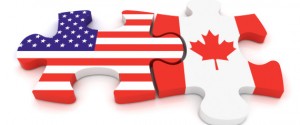Even though when we think about North America, Canada and the U.S always come together, the cultures and people behaviors are quite different. Alan Middleton, assistant professor at the Schulich school of business at York University, has generalized several differences. Firstly, he said canadians are more cautious. “we are more cautious, we are slow adopter of new things, new technology, new products than our friendly down south.”
I think this difference is largely due to the different life styles in these two countries . Compare to America, Canada is more relax. Canadians like to travel, skiing and enjoy their own time rather than work all the time. As a result, we are slower adopter for new objects.
Another culture difference that Middleton found was that “America is a much more deeply innovative and experimental culture. We are much more value culture.”He explains that this is a reason why online shopping grows a lot more slower in Canada than the U.S. Because we are value orientated, we want to actually see the product. Also, because of this, we tend to buy things for long term use and Americans like to search for newness .
Consumer behaviors is not a independent concept, it is just a part of our life style. People are different, so it is very complex to be specifically analyzed. Even though we say that Canadians are more leisure and Americans are more busy. These differences are not very obvious on younger generations, due to the global economic and high technology median. However, the younger generations might have some other differences that their parents don’t have. Marketing study on consumer behaviors is not a once for all event, people will always change as tome goes by.
Reference:
Schulich marketing professor explains the difference between Canadian and American consumer (2012) http://media.schulich.yorku.ca/faculty/schulich-marketing-professor-explains-the-difference-between-canadian-and-american-consumers/



